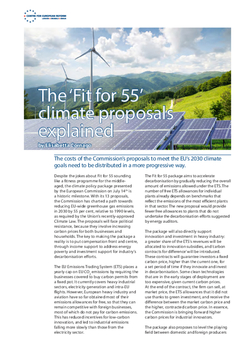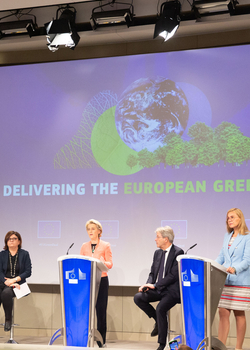
The 'Fit for 55' climate proposals explained
The costs of the Commission’s proposals to meet the EU’s 2030 climate goals need to be distributed in a more progressive way.
Despite the jokes about Fit for 55 sounding like a fitness programme for the middle-aged, the climate policy package presented by the European Commission on July 14th is a historic milestone. With its 13 proposals, the Commission has charted a path towards reducing EU-wide greenhouse gas emissions in 2030 by 55 per cent, relative to 1990 levels, as required by the Union’s recently-approved Climate Law. The proposals will face political resistance, because they involve increasing carbon prices for both businesses and households. The key to making the package a reality is to put compensation front and centre, through income support to address energy poverty and investment support for industry’s decarbonisation efforts.
The key to make the Fit for 55 package a reality is to put compensation for increasing carbon prices front and centre, through income support against energy poverty, and investment support for decarbonisation efforts.
The EU Emissions Trading System (ETS) places a yearly cap on EU CO2 emissions emissions by requiring the businesses covered to buy carbon permits from a fixed pot. It currently covers heavy industrial sectors, electricity generation and intra-EU flights. However, European heavy industry and aviation have so far obtained most of their emissions allowances for free, so that they can remain competitive with foreign businesses, most of which do not pay for carbon emissions. This has reduced incentives for low-carbon innovation, and led to industrial emissions falling more slowly than those from the electricity sector.
The Fit for 55 package aims to accelerate decarbonisation by gradually reducing the overall amount of emissions allowed under the ETS. The number of free ETS allowances for individual plants already depends on benchmarks that reflect the emissions of the most efficient plants in that sector. The new proposal would provide fewer free allowances to plants that do not undertake the decarbonisation efforts suggested by energy auditors.
The package will also directly support innovation and investment in heavy industry: a greater share of the ETS’s revenues will be allocated to innovation subsidies, and ‘carbon contracts for difference’ will be introduced. These contracts will guarantee investors a fixed carbon price, higher than the current one, for a set period of time if they innovate and invest in decarbonisation. Some clean technologies that are in the early stages of deployment are too expensive, given current carbon prices. At the end of the contract, the firm can sell, at market price, the ETS allowances that it did not use thanks to green investment, and receive the difference between the market carbon price and the higher, contracted carbon price. In essence, the Commission is bringing forward higher carbon prices for industrial innovators.
The package also proposes to level the playing field between domestic and foreign producers of cement, iron and steel, aluminium, electricity and fertilisers with a carbon border adjustment mechanism (CBAM). This mechanism would impose a cost of carbon on imports of these goods into the EU, eventually replacing the free allocation of ETS emissions allowances. But the timeline for ending free allowances, which will be phased out by 2036, is not ambitious enough. If the 2030s are ‘the decisive decade’ for climate action, as the Commission insists, it should not wait 15 years to apply the ‘polluter pays’ principle to industry.
Households have not yet felt the full impact of carbon pricing, because of the limited scope of the ETS. This would change with the proposal for a new ETS, beginning in 2026 and separate from the existing scheme to start with, to cap pollution from road transport and heating, both of which are largely powered by fossil fuels. The Commission also wants national taxes on heating and transport fuels to be set according to their energy content and environmental performance, which is currently not always the case.
These proposals would lead to higher prices at the pump and higher heating bills, which would disproportionately hit lower-income households, who spend a higher share of their income on transport and heating. To mitigate that hit to incomes, the Commission plans to put 25 per cent of the revenues from the new ETS into a Social Climate Fund. The fund will launch in 2025, one year before carbon pricing starts applying to buildings and road transport. Frontloading this kind of compensation is important, in order to make climate action fairer and more effective: transfers are necessary to offset fuel price increases. But the Commission’s proposal needs to be bolder and more detailed: the carbon price of this new ETS needs to be made stable and predictable, to give households guidance on future costs; and a larger share of revenues of the new ETS should go into the Social Climate Fund, to make the scheme politically acceptable while creating strong incentives for households to invest in reducing their emissions.
In addition to price signals – energy taxes and ETS carbon prices – to encourage households to shift away from natural gas heating and petrol or diesel cars, the Commission is also proposing regulations to lower carbon emissions. For example, if adopted, new standards for car and truck emissions would end sales of combustion engine vehicles in 2035.
The proposals for the power sector seek to increase the share of renewable energy sources to 40 per cent of final energy consumption, and to reduce energy demand, by making the EU-wide energy-efficiency target binding. Both aims are welcome and necessary to achieve the 2030 climate goals, but there are challenges. 60 per cent of the EU’s renewable energy still comes from biomass – from forests, municipal waste, and agricultural and wood-working residues. Today, the dependency on biomass needs to be squared with the EU’s ambitious biodiversity and forestry strategies: this will require stringent criteria to ensure that biomass use is environmentally sustainable.
The new EU-wide target for energy-efficiency would be binding, and paired with indicative national-level targets. Energy-efficiency improvements in transport and industry are largely in the hands of industrial players and can be encouraged with carbon prices, standards and, if needed, subsidies for innovation. Efficiency improvements in housing are in the hands of households: poorer people will need support in order to afford the costs of renovation. Many member-states are offering renovation subsidies as part of their recovery plans, but more investments will be needed.
To get the #Fitfor55 package over the line, Europe must stand its ground on carbon price signals & regulatory standards, be bold in addressing the distributional impacts of climate action & raise its climate diplomacy efforts ahead of COP26.
Overall, the proposals are ambitious, and long negotiations loom between the Commission, the member-states and the European Parliament. To get the package over the line and reach its targets, Europe must:
- Resist the call from some member-states to water down price signals. Reaching the ambitious climate targets without strong and consistent price signals will not work. Price signals are not sufficient, but they are a necessary foundation of climate action.
- Stand its ground on regulatory requirements. Regulation sets minimum standards to force innovation, and adds further credibility to price signals. The main political battle here is the phase-out of combustion engine cars.
- Be bold in addressing the distributional impacts of the energy transition. Richer households, richer businesses and richer member-states should shoulder a larger share of the cost of climate action. Avoiding these discussions is not an option: climate inaction would have even more unequal outcomes.
- Lead the world in climate action. The EU needs to raise its climate diplomacy efforts ahead of the COP26 climate negotiations in Glasgow: it should encourage the US and China to match its own policy efforts, and it should step up its support for developing countries to help them in the energy transition.
Elisabetta Cornago is a research fellow at the Centre for European Reform.


